AFERIY P210 2400W Power Station Review [In-Depth & Unbiased 2025]
In the 5 years since we first discovered power stations, we have gone on to review dozens of them.
Using them personally for van trips, campaign trips, as a stop-gap when installing an off-grid system on our boat.
So we know what makes the best portable power stations, and what sorts of features different users want.
And one thing we quickly realised when reviewing the AFERIY P210 2400W power station, is that it’s FANTASTIC value for money …
Potentially.
Not all power stations suit all users, but it’s entirely possible this is THE best power station for you in terms of budget and output.
I want to explain why I feel this way by laying it all out below, so let’s get straight into it …
(p.s. stay tuned til the end for some cheeky discounts!)
Who are AFERIY?
Let’s start by addressing the obvious … who are AFERIY?
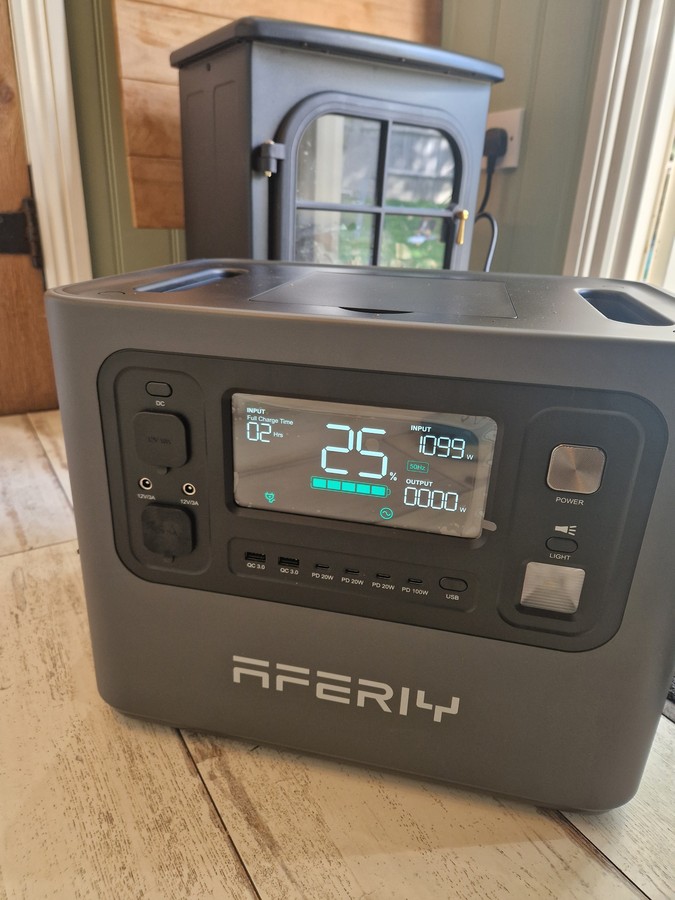
They’re certainly not the biggest name in town, and if you’re new to this world you’ve likely heard bigger names thrown around like Jackery and BLUETTI.
Well the truth is they are still an expanding company, very much up and coming; but certainly not new. Having operated since 2017.
AFERIY is a Shenzhen-based technology company specializing in a range of portable energy solutions. Offering direct sales through dedicated websites and support for North America, Europe, and other markets.
The company was founded by a team of engineers with a mission that recognizes “a safe and reliable power supply is essential— whether it's for everyday life, outdoor adventures, work, or emergency relief.”
AFERIY positions itself as an “Energy Guardian,” aiming to eliminate what it calls “energy anxiety.” With more than five years in the portable power industry, AFERIY has established itself as a recognized global player.
Where to buy AFERIY power stations?
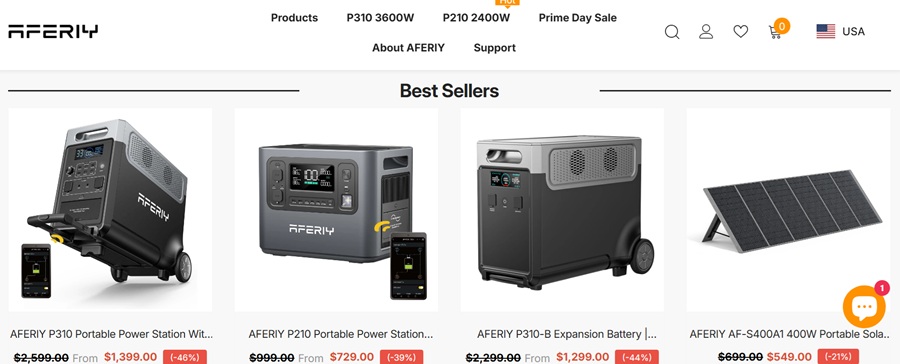
The best place is direct through their website. And they have dedicated sites for each locale. Where exact features on stations (and ranges) can vary slightly.
For example, the model we tested came direct from their UK store, and is of course set up for our UK plug adaptors and the European 230V system.
So even though in pictures you see UK 3-pin plugs, don’t stress. The local units are set for your market, such as with USA 2 pin plugs.
These exact locals on offer (at the time of writing) are:
So what products does AFERIY sell?
Their core range of power stations include:
- P310 – High-capacity model (≈ 3600W / 3840Wh)
- P210 – 2400W / 2048Wh with app / Bluetooth control
- P110-D – Mid-range (≈ 1200W / 960Wh)
- P010 – Lighter / lower power station (≈ 800W / 512Wh)
- P040 – Smaller-capacity unit (≈ 400W / 256Wh)
- Nano100 – Very portable / lightweight backup / charging unit (≈ 100W / 99.2Wh)
They also offer a range of solar panels including:
- S400A1 / S400 - 400W foldable/portable
- S200A1 / S200 - 200W foldable/portable
- SG120 - 120W glass/solid
- S100A1 - 100W foldable/portable
- S60 - 65W foldable/portable
- SL30 - 30W foldable/portable
They also offer a range of solar generator kits.
What’s the difference between a solar generator and a portable power station?
Well, the former is simply a power station + solar panel bundle. Meaning that you can generate and use your own power, without the need to top up the power station any other way (as long as there is sun of course).
Below we are actually testing both the P210 + the S400A1. Which in my opinion is a decent setup. Such a large capacity typically means your usage is relatively high, and to either keep that topped up, or fill from empty, you want as much solar as possible.
And the S400A1 really is a beast (more on that to come).
AFERIY P210 Key features
High Capacity + Strong Output

One of the first things that jumped out at me with the AFERIY P210 is just how much raw power it packs in. With a whopping 2,048Wh of capacity and a 2,400W inverter (peaking around 4,800W), it doesn’t blink when you plug in a bigger kit.
I ran a kettle & toaster off it without a hiccup, which is something many smaller stations can’t dream of. For UK households, that means you could realistically keep the fridge, WiFi, lights, and even potentially a washing machine going during a blackout.
That said, raw power comes with a trade-off. At around 22kg, this isn’t something you sling around casually. It’s portable in the sense that two sturdy handles let you lug it from the garage to the garden, but I wouldn’t be hiking it far.
One thing to mention is that under continual heavy load, you will hear the cooling fan kick in. This noise is not unbearable, but noticeable in a quiet living room.
It’s worth pointing out that all larger models I’ve tested and used have had fans to kick in to help cool them down under heavy load or heavy charge. It’s just part and parcel. So not so much a negative, just a bit of insight before possible purchase.
Fast Charging Options

Where the P210 really impressed me was charging speed. Plug it into the wall and you can pull in up to 1,100W, which means you’re looking at a full charge in roughly two hours. Add solar into the mix (up to 500W) and you can shave that time even further with the AC + solar combo.
This is a BIG deal and something you really need to consider if looking elsewhere at these larger stations. The ability to actually handle faster charging isn’t ubiquitous and is super convenient if you suddenly need to rush out with the unit but note that it wasn’t fully recharged yet.
It could easily take 8 hours to charge a unit of this size without fast charging capability. Admittedly, you don’t always want or need this capacity so think carefully about your needs. But do note that you can adjust these charging speeds to suit your wants. Which leads us nicely onto …
App / Remote Control & Monitoring

AFERIY has made a really solid effort on the “smart” side too, with their companion app. It connects over Bluetooth (no Wi-Fi/cloud just yet), and once paired, you can see input/output stats, remaining time, and even adjust charging speed.
I found it surprisingly smooth to use, with a clean interface and almost no lag. A lot of the time these apps are more gimmicky than offering much of an upgrade to the user. But because of the advanced kit and charging options, the app is genuinely useful.
First up, you can use it to adjust the charging speed of the unit. To help preserve any batteries, charging at a slower speed can really help in prolonging their life, and you have full control over this on the AFERIY through the app. So you don’t HAVE to have fast-charging enabled if you don’t want it.
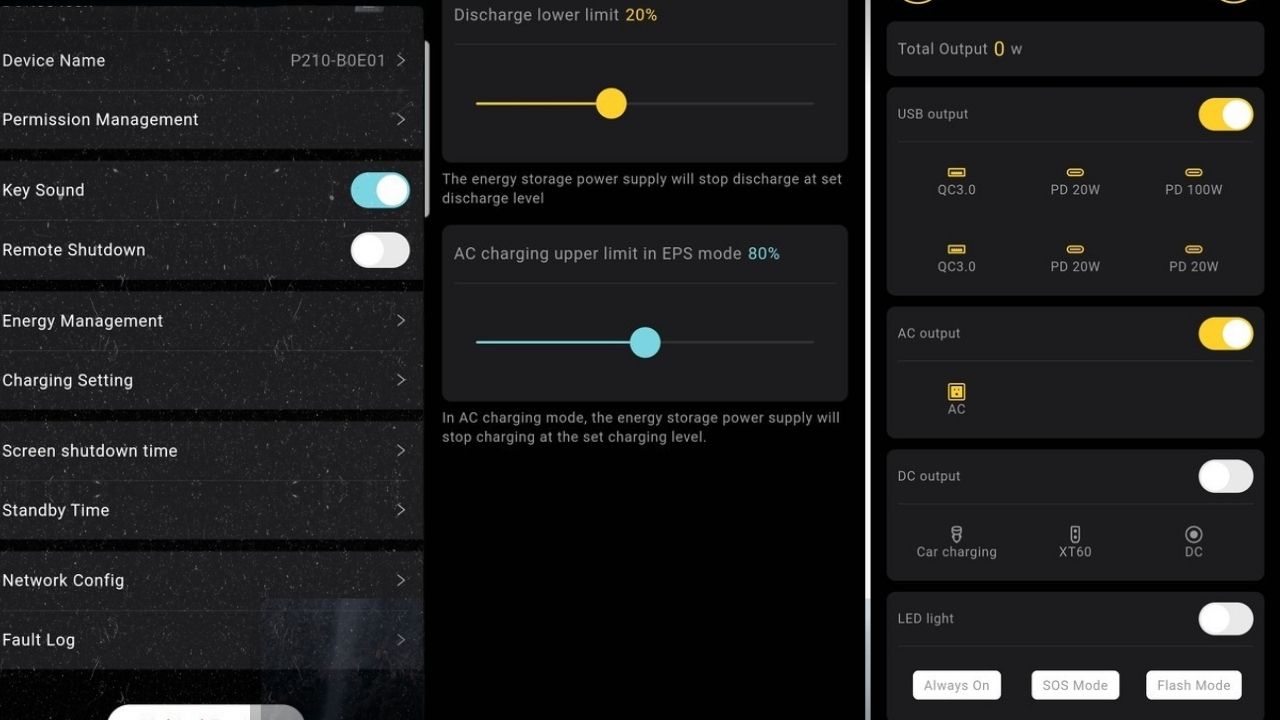
Another useful feature through the app that you can use to prolong battery life is to set the battery charge and discharge limits. They say that for lithium batteries 20%-80% is an ideal range. It’s completely up to you and you can tweak these settings whenever you need to.
If nothing else, then you can use the app to turn the lights on the unit on and off. Which I have actually found useful on previous units when camping. You can be all tucked up in your sleeping bag on one side of the tent and use the app to turn the power station off from the other side, without the need to get out and get cold!
So yes, overall it’s less of a novelty app and more of a practical tool, which is great to see!
Rugged & Portable Design
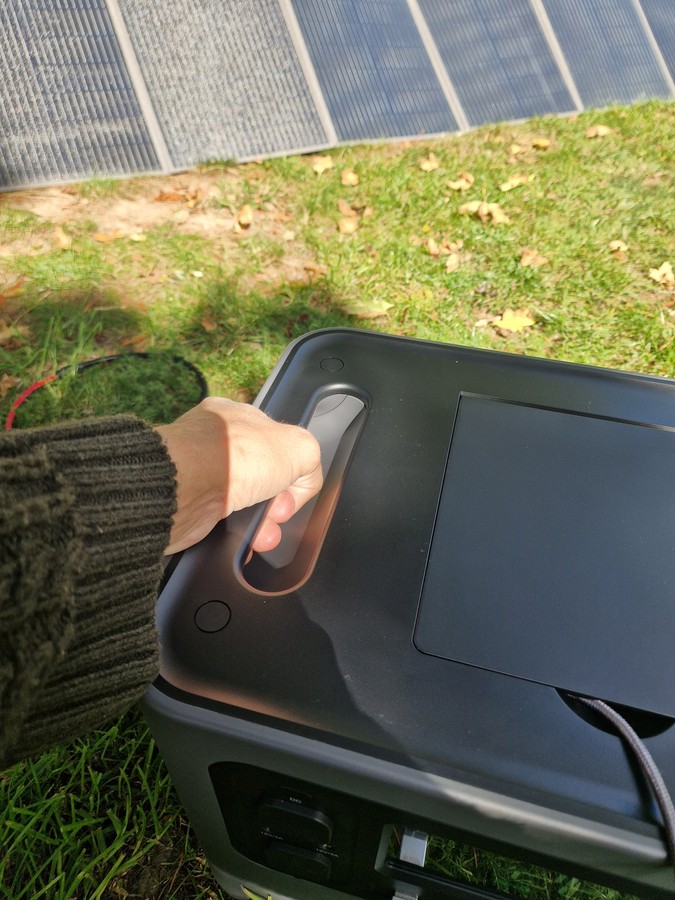
Let’s talk about the elephant in the room … Yes, it’s heavy. At 22kg, the P210 is not your featherweight companion. But AFERIY clearly knew this and built the housing tough, with dual handles that actually make moving it around manageable.
I lugged it between rooms and into the camper van without too much drama — think “two-handed carry” rather than “back-breaking lift.” For a like-for like comparison, here’s some comparison stats on the Anker Solix F2000 and BLUETTI AC200L (both of which I have reviewed):
- AFERIY P210 - 2,048Wh / 2400W - 22kg
- Anker Solix F2000 - 2,048Wh / 2400W - 30.5kg
- BLUETTI AC200L - 2,048Wh / 2400W - 28.3kg
So in like-for-like models (ignoring any other features on the unit itself) the P210 could actually be considered extremely lightweight! I will admit that at this capacity level, having the carry handle & wheels like the Anker F2000 does is a very useful feature.
But in reality you aren’t often lugging these units around. And removing the wheels and handles reduces dimension sizes massively. Interestingly, they opted for wheels and carry handle on the larger P310 model. So if that maneuverability is a deal breaker for you, it’s worth checking that out.
The casing itself feels durable, with reinforced corners and a matte finish that resists scratches. I’d say the build quality feels more “industrial” than plasticky. It looks like something you’d trust in a workshop as much as a campsite.
That said, the design isn’t exactly stylish, and the grey/silver aesthetic might not win design awards. The screen is bright and clear indoors. Minor gripes aside, the P210 is built for function over fashion, and in that sense, it nails the brief. It’s about as “sexy” as a power station can be I suppose!
Long Battery Life / Durability
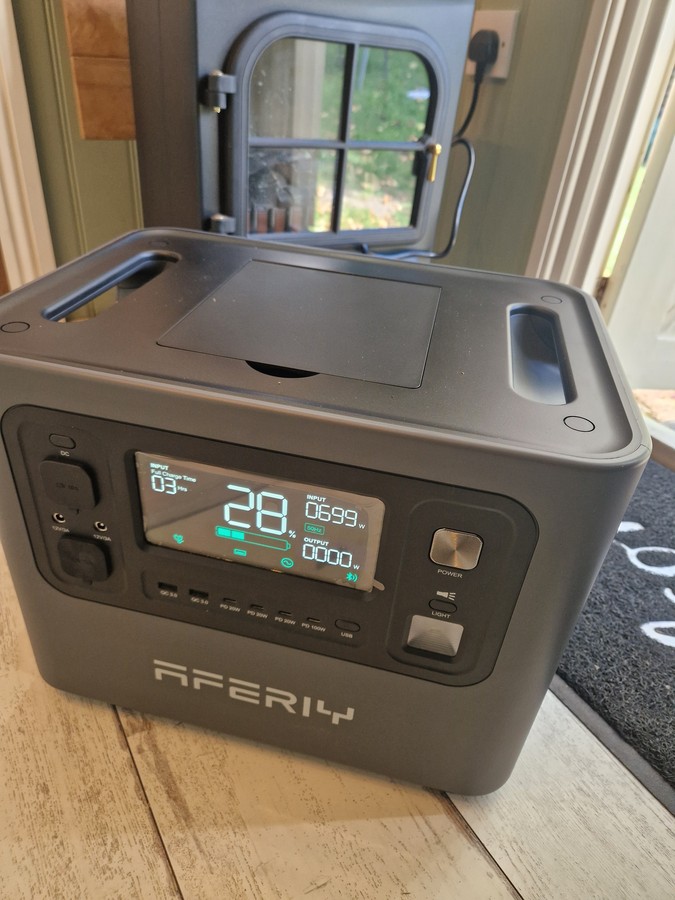
One of the things I really love about the P210 is the peace of mind you get from its LiFePO₄ battery. We’re talking 3,500–4,000 full cycles before it dips to 80% capacity.
In real terms, that’s a decade of use if you cycle it daily — and let’s be honest, most of us won’t hammer it that hard. Add in a chunky 7-year warranty, and you’ve got one of the most reassuring packages on the market.
The integrated BMS (battery management system) keeps everything safe, automatically protecting against overheating, overcharging, and short circuits. I pushed it with high-draw appliances, and it never felt warm to the touch, which is reassuring.
Multiple Output Ports & Versatility
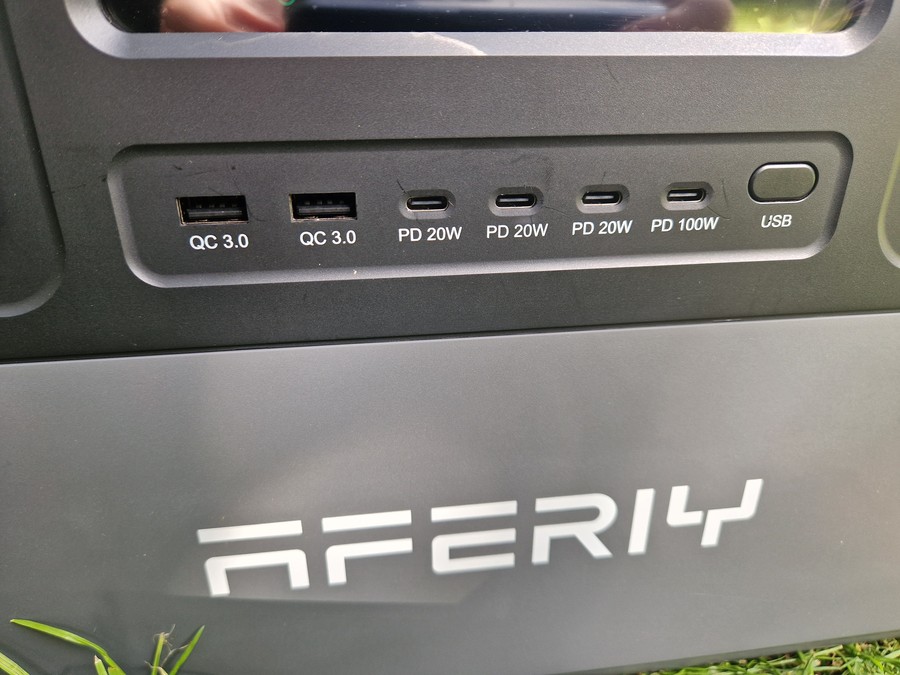
If you’re anything like me, you’ll appreciate options. The P210 delivers in spades, with a mix of AC sockets (UK model comes with three), USB-A, USB-C (including a 100W PD port for faster charging things like laptops), DC barrel ports, and a car socket.
That means you can run a fridge, charge phones, and keep a drone battery topped up — all at once. The layout is intuitive, with clearly labelled ports and a decent amount of spacing so bigger plugs don’t block their neighbours.
Which has definitely been an issue on many power stations I have reviewed! Often you find it’s an issue with the UK market variant where the plugs are naturally much larger than the US / European 2 pin counterparts. Just check that the number of plugs on your variant is enough for your expected needs.
Nowadays most appliances can be charged directly from USB’s, meaning that you can have a bunch of tablets and laptops charging on a family caravan holiday for example, without anyone having a hissy fit.
A little feature I love …

I wasn’t sure where to include this, but one feature of the unit I actually found super practical was the storage box on the top. In other portable power stations I’ve used, this space on top is either as a wireless charge spot or as … well … nothing. A place to put a cup of tea when outside, maybe.
But on the AFERIY they’ve turned it into a storage space. Which, though simple, was surprisingly practical. It has a recessed opening which I quickly realised is (presumably) so that you can run cables through it and tidily tuck charging devices out of the way.
Or alternatively you can use it to store your charging cable.
This is no small deal. I have lost multiple charge cables for these power stations when testing or storing; and this is actually super convenient. Trust me. Or maybe you can relate if you’ve used a few power stations in the past. Either way, I love it.
AFERIY S400AI 400W solar panel review
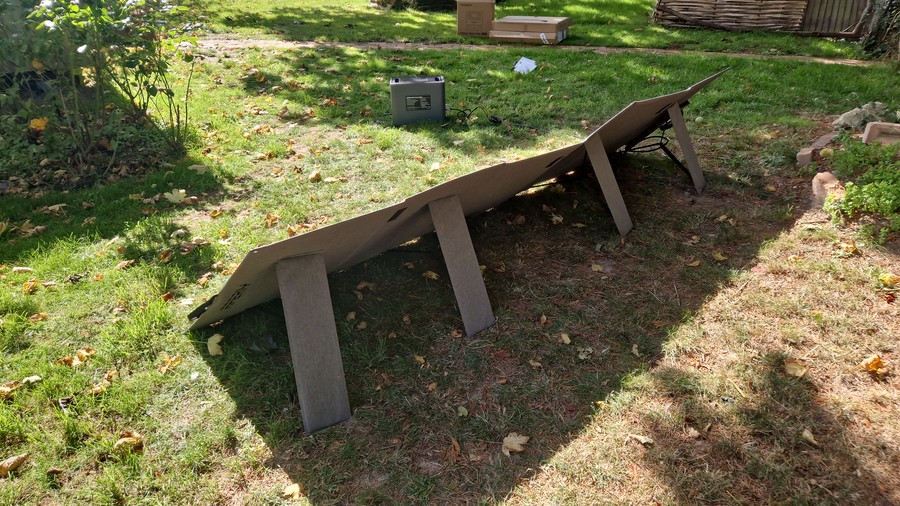
While reviewing the P210, I also managed to get my hands on the AFERIY AF-S400 folding solar panel. And as someone who lives for van trips, weekend camps, and keeping devices charged during outages, this thing is a BEAST.
At 400W this is a really useful piece of kit in he right conditions. It weighs in at about 9.25kg (≈ 20 lbs) and folds down reasonably compact. Don’t expect to sling it over your shoulder for miles without noticing. I’ve never tested a foldable panel above 200W before so I was super curious about this.
When unfolded and set correctly using the built-in kickstand, it delivers up to 400W in ideal conditions with monocrystalline cells boasting ~23% efficiency. That means on bright, sunny days you can make serious headway toward charging a P210 or P310 power station.
Even on overcast days, the 400W spec is ambitious — expect more like 300-320W practical output in less than perfect light. It’s worth noting that 23% efficiency is insanely good. Rigid household panels rarely go much above this in terms of efficiency (though they achieve better actual real world numbers - and don’t suffer from as many overheating issues).
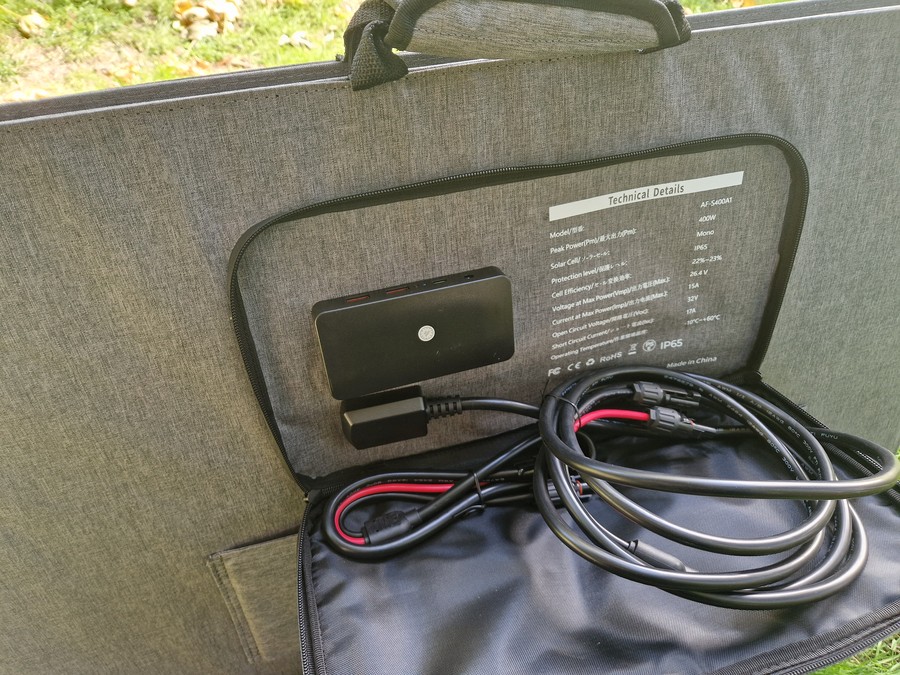
The build quality of the panel is solid. The materials are multilayer, with MWT/ETFE lamination, and the panel has an IP65 rating for water/dust resistance. That’s great for outdoors, though IP65 isn’t “submerged” safe — heavy downpours over time might stress seams.
The folding design is intuitive, and the kickstand mechanism works well: it lets you angle the panel properly without needing extra mounts. One slight annoyance: size when folded is still bulky. The folded dimensions (~720 × 540 × 70mm) are visually impressive; it’s big for storage in small vehicles.
Also, while USB-A / USB-C outputs are nice for charging phones etc directly off the panel, don’t expect those small ports to contribute much to overall power when pushing the panel’s full capacity. They’re more for topping up smaller devices.

Overall, if you’re in the market for a high-output portable solar panel and don’t mind a bit of size and weight, the AF-S400 delivers excellent bang for your buck. It excels in campervans, moderate off-grid use, or backup setups. For ultralight hikers or minimalist setups, though, it might feel overkill.
I wouldn’t take it camping for 2 days, but for a couple weeks, or even as a semi-permanent setup on the roof of our home I think it’s absolutely ideal! For less output (but still a decent amount) coupled with much better portability, strongly consider the 200W panel variant that EFIRY offers.
Overall verdict - Is this power station worth buying?
I’m going to come straight out of the gate here with possibly the most important factor with the AFERIY P210.
It is FANTASTIC value for money.
Seriously.
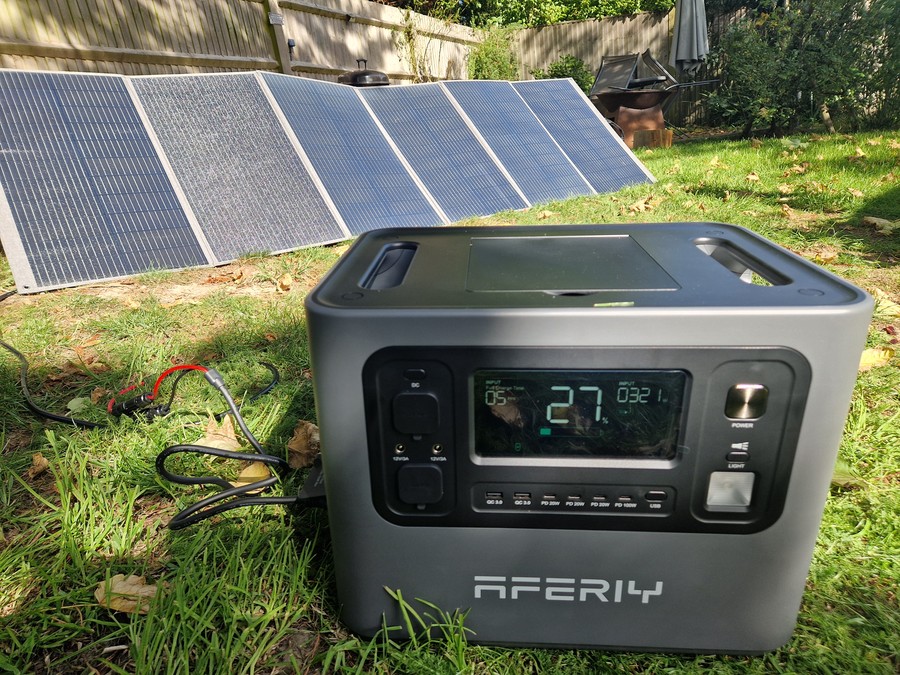
It is not perfect. No power station is. It lacks wheels and a carry handle which reduces its portability, and maybe you don’t like that it’s not as weather-resistant as some units. But beyond those things (which may not even matter for 90% of users) it is hard to find fault.
I genuinely think it is a phenomenal piece of kit. Naturally, I haven’t had months or years to test, but from putting it through its paces it held up exactly as advertised. And when comparing with the like-for-like features of similar capacity models, it is spot on in terms of functionality.
But perhaps more importantly, it’s cheaper.
And you may think, “AFEIRY isn’t perhaps as well known as some other brands …”. But a 7 year warranty goes a long way in reducing any concerns you may have regarding this brand-visbility. Any issues and they are on hand to offer support and fix things.
Do I think it’s the ideal station for all users? Absolutely not.
It may well have far too much power for what you need, or it may be lacking (look at their larger unit if so).
One thing to note is that it doesn’t offer expansion capabilities; which some people do like the option of having such as with the BLUETTI AC200L. But if you know this is the station for you for years to come, then there is little fault to find and perhaps well worth giving it a go.
AFERIY power station discount codes
For US customers:
Product: AFERIY P210 2400W Portable Power Station / Code: dreamP210
Product: AFERIY S400A1 400W Solar Panel / Code: dreamS400A1
Product: All products / Code: dream6OFF
discount: 6% off
For UK customers:
Product: AFERIY P210 2400W Portable Power Station / code: dreamP210
Product: AFERIYS400A1 400W Solar Panel / code: dreamS400A1
Product: All products / code: dream6OFF
discount: 6% off
Final thoughts
With continuing advances in lithium battery technology it seems power stations as a whole over the last 4 or 5 years have come such a long way. In terms of capacity and weight things seem to be getting ever more favourable.
And there are now so many power stations out there to choose from. I recommend carefully checking out the exact variant features of the AFERIY P210 in your chosen territory before purchasing. Just so you can be sure it’s the right one for you.
If you need any other help from me, please just drop a comment below and I’ll help where I can.
In the meantime, you may also be interested in one of these other guides:



Leave a comment
Let us know what you think!